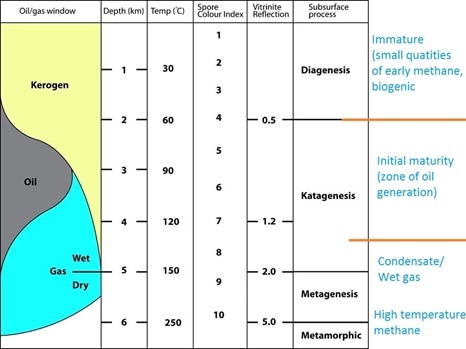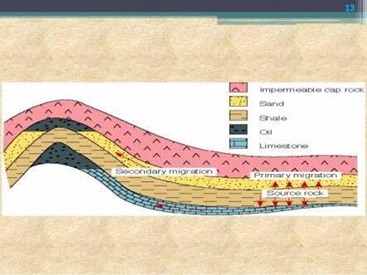|
Petroleum Generation (Maturation Process)
Petroleum is generated from productive source beds which have high organic carbon content. This high organic carbon content resulted from the burial of plants and animals. Maturation process occurs through millions of years and the higher the rock quality is, the more mature it is. Diagenesis, the chemical reaction process that occurred first few thousand years after burial at temperatures less than 50°C. During this process oxygen, nitrogen and sulfur are removed from the organic matter leading to an increase in hydrogen content of the sedimentary organic matter. About 10 to 20% of petroleum is formed during this process. Catagenesis, the reactions that occur between 60 and 200°C. During catagenesis, the organic compounds are exposed to diverse thermal degradation reactions that include double bonds reduction by adding sulfur or hydrogen atoms, cracking reactions and condensation reactions. Metagenesis, takes place at temperatures over 200°C and is considered to be a type of very low-grade metamorphism. Most petroleum is formed during the catagenesis and metagenesis of the residual biogenic organic matter. Converting biomolecules into petroleum is called maturation. After petroleum generation it migrates until it is trapped. So, a brief overview about the migration process in indicated in the next section. Petroleum migration
After fracturing of source rock due to pressure increase that happens due to the generation of oil and gas. Since gases and liquids are less dense than solids, they take up more volume causing pressure increase. So, it is important for a productive source rock to be easily fractured to let the fluids move through it. Migration occurs in two stages: Primary migration During primary migration, gas and oil travel together as a single liquid phase because the high pressures in the source rock which usually become higher than the bubble point pressure at which gases start to be liberated from liquid. Expulsion from the source rock may occur in pulses and after some time from the first expulsion. With time, petroleum creates enough pressure to reopen fractures and pores causing a second expulsion, and the pulses continue to happen as long as the petroleum can rebuild enough pressure to reopen its path out of the source rock. After migration the pressure decreases and the fractures and pores close. Finally, petroleum migrates out of the source rock, pressures decline, especially if the petroleum migrates vertically. Secondary migration Secondary migration is the movement of petroleum outside of the source rock and into a reservoir bed. During secondary migration, the gas and oil separate with the gas traveling ahead of oil. In most cases, differences in permeability between adjacent stratigraphic layers inhibit migration.This causes petroleum to flow within geologic units. For petroleum to accumulate in a trap, it must encounter a cap rock or seal to become an oil or gas reservoir. |
Author
Napat Tangjaichuychat
Editor
Poomisant Srimaharaja |
PETROLEUM GEOLOGY
- Home
- Introduction
-
Content
- Petroleum Geochemistry
- Origin of Petroleum >
- Accumulation and Traps >
- The Reservoir >
- Shale oil >
-
More about Petroleum
>
- Types of drilling bits
- Crude oil emulsion
- Drilling Fluids/Mud and Components
- Oil-Rich Countries
- Facts about Petroleum
- Oil Measurement Unit
- Forecast of Energy Usage
- Exploration Techniques
- Geologist & Engineer
- Impacts on environment
- World Reserves
- Petroleum in Thailand
- NOC & IOC
- Digital Oilfields
- Career in PE
- Blowout Preventer(BOP)
- HSE Basic Concepts
- Geophysics >
- From Exploration to Refining
- Well logging
- Real-Time Oil Price
- Glossary of Oil and Gas Terms
- Petroleum management systems
- Contact
- About


